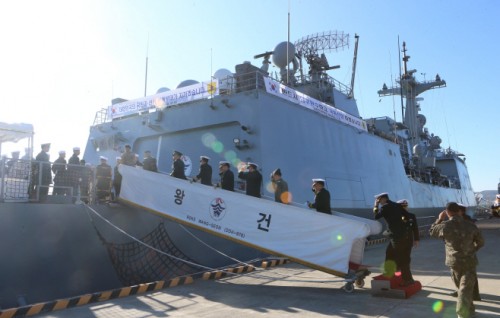 |
| The 31st contingent of the Cheonghae Unit aboard the destroyer Wang Geon from a naval base in Busan/ Source: South Korea’s Naval Operations Command (NOC) |
By AsiaToday reporter Lee Jang-won
South Korea will dispatch troops to the Strait of Hormuz. The Cheonghae Unit will operate independently instead of joining the U.S.-led International Maritime Security Construct (IMSC). Seoul’s decision came as it sought a delicate balance between Washington and Tehran. The Cheonghae Unit will prioritize the safety of South Korean people and vessels passing through the strategic waterway.
“The government has decided to temporarily expand the Cheonghae Unit’s sphere of activity in order to guarantee safety of our people and the freedom of navigation of our vessels,” the defense ministry announced Tuesday. “We have been reviewing diverse options since May last year when tensions began to heighten in the Middle East,” a defense ministry official said, adding that the government prioritizes the safety of South Korean people, vessels and stable transportation of crude oil in case of emergency.
As a result, the Cheonghae Unit, which has been on its mission in the Gulf of Aden off Somalia, will broaden its mission areas into the Gulf of Oman, and further to the Persian Gulf. “South Korean ships sail through Hormuz about 900 times per year, which requires a prompt response from the military in an emergency,” the ministry said.
“Under the command of our military, the Cheonghae Unit will protect South Korean nationals and vessels,” the ministry said. While announcing the decision in response to U.S. calls for help, the South Korean defense ministry stressed that the naval unit will operate independently from a U.S.-led military coalition there. The ministry official said Seoul had discussed the matter with Washington prior to the announcement.
However, the ministry has left the door open for possible joint operations with other countries, saying, “Although the Cheonghae Unit will be conducting independent operations in an expanded operational area, it will cooperate with the U.S.-led IMSC when needed.” The ministry remained cautious about joining the U.S.-led IMSC, saying, “It will be within the scope and limitations of the Cheonghae Unit.”
The government’s decision was a result of its deep concern over the recent rise in tensions in the Middle East, which increased the need to protect South Korean nationals and vessels passing through the Hormuz. Some 25,000 South Koreans reside in the Middle East, and the Strait of Hormuz is the route to the open ocean for nearly 70 percent of South Korea’s oil imports.
The 31st deployment of the Cheonghae Unit, being conducted by the destroyer Wang Geon, took over operations Tuesday from the Gang Gam Chan in the Port of Muscat to protect Korean vessels and nationals passing through the Hormuz. “The Wang Geon is equipped with excellent anti-aircraft and regional defense capabilities, and it is expected to fully carry out the mission,” said Kwon Yong-soo, former professor at Korea National Defense University. “Excluding political dynamics with Washington and Tehran, it is a definitely a helpful move to protect South Korean nationals and vessels,” he added.
The ministry official said the dispatch decision does not require parliamentary consent, as the law stipulates that the unit shall carry out missions in the Gulf of Aden and its surrounding regions. It is also allowed to launch activities in designated waters to protect citizens in case of emergency.
#Cheonghae Unit #Hormuz #IMSC
Copyright by Asiatoday
Most Read
-
1
-
2
-
3
-
4
-
5
-
6
-
7





















